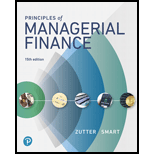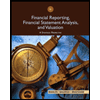
Gitman: Principl Manageri Finance_15 (15th Edition) (What's New in Finance)
15th Edition
ISBN: 9780134476315
Author: Chad J. Zutter, Scott B. Smart
Publisher: PEARSON
expand_more
expand_more
format_list_bulleted
Concept explainers
Question
Chapter 16.3, Problem 16.10RQ
Summary Introduction
To discuss: The difference between domestic and international transactions and the way in which the letter of credit is used in financing international trade transactions.
Introduction:
An external type of financing that have a shorter time span for repaying the loan back is termed as short-term financing. This type of financing has less interest rate as compared to the long-term financing. Every company relies on short-term financing from external sources.
Summary Introduction
To discuss: The way in which the netting used in transactions between subsidiaries.
Expert Solution & Answer
Want to see the full answer?
Check out a sample textbook solution
Students have asked these similar questions
The image is blurr please comment i will write values.
please dont Solve with incorrect values otherwise unhelpful.
Question 6
A five-year $50,000 endowment insurance for (60) has $1,000 underwriting expenses, 25% of the first
premium is commission for the agent of record and renewal expenses are 5% of subsequent premiums.
Write the gross future loss random variable:
Presuming a portfolio of 10,000 identical and independent policies, the expected loss and the variance
of the loss of the portfolio are given below (note that the premium basis is not given or needed):
E[L] = 10,000(36,956.49 - 3.8786P)
V[L] 10,000 (50,000 + 14.52P)². 0.00095
Find the premium that results in a 97.5% probability of profit (i.e. ¹ (0.975) = 1.96).
Premium:
Please show your work below
What corporate finance??
can you explain this?
fully
no ai
Chapter 16 Solutions
Gitman: Principl Manageri Finance_15 (15th Edition) (What's New in Finance)
Ch. 16.1 - What are the two major sources of spontaneous...Ch. 16.1 - Prob. 16.2RQCh. 16.1 - Prob. 16.3RQCh. 16.2 - How is the prime rate of interest relevant to the...Ch. 16.2 - How does the effective annual rate differ between...Ch. 16.2 - What are the basic terms and characteristics of a...Ch. 16.2 - What is a line of credit? Describe each of the...Ch. 16.2 - What is a revolving credit agreement? How does...Ch. 16.2 - Prob. 16.9RQCh. 16.3 - Prob. 16.10RQ
Ch. 16.3 - Are secured short-term loans viewed as more risky...Ch. 16.3 - In general, what interest rates and fees are...Ch. 16.3 - Describe and compare the basic features of the...Ch. 16.3 - For the following methods of using inventory as...Ch. 16 - Prob. 1ORCh. 16 - Prob. 16.1STPCh. 16 - Prob. 16.1WUECh. 16 - Prob. 16.2WUECh. 16 - Prob. 16.3WUECh. 16 - Prob. 16.4WUECh. 16 - Horizon Telecom sold 300,000 worth of 120-day...Ch. 16 - Prob. 16.1PCh. 16 - Learning Goal 1 P16-2 Cost of giving up early...Ch. 16 - Prob. 16.3PCh. 16 - Learning Goal 1 P16-4 Early payment discount...Ch. 16 - Prob. 16.6PCh. 16 - Prob. 16.7PCh. 16 - Prob. 16.8PCh. 16 - Learning Goal 3 P16-9 Cost of bank loan Data...Ch. 16 - Unsecured sources of short-term loans John Savage...Ch. 16 - Learning Goal 3 P16-11 Effective annual rate A...Ch. 16 - Prob. 16.12PCh. 16 - Compensating balance versus discount loan Weathers...Ch. 16 - Prob. 16.14PCh. 16 - Cost of commercial paper Commercial paper is...Ch. 16 - Prob. 16.16PCh. 16 - Prob. 16.17PCh. 16 - Prob. 16.18PCh. 16 - Prob. 16.19PCh. 16 - Inventory financing Raymond Manufacturing faces a...Ch. 16 - ETHICS PROBLEM Rancco Inc. reported total sales of...
Knowledge Booster
Learn more about
Need a deep-dive on the concept behind this application? Look no further. Learn more about this topic, finance and related others by exploring similar questions and additional content below.Similar questions
- What is corporate finance? how this is usefull?arrow_forwardPam and Jim are saving money for their two children who they plan to send to university.The eldest child will enter university in 5 years while the younger will enter in 7 years. Each child is expected spend four years at university. University fees are currently R20 000 per year and are expected to grow at 5% per year. These fees are paid at the beginning of each year.Pam and Jim currently have R40 000 in their savings and their plan is to save a fixed amount each year for the next 5 years. The first deposit taking place at the end of the current year and the last deposit at the date the first university fees are paid.Pam and Jim expect to earn 10% per year on their investments.What amount should they invest each year to meet the cost of their children’s university fees?arrow_forwardPam and Jim are saving money for their two children who they plan to send to university.The eldest child will enter university in 5 years while the younger will enter in 7 years. Each child is expected spend four years at university. University fees are currently R20 000 per year and are expected to grow at 5% per year. These fees are paid at the beginning of each year.Pam and Jim currently have R40 000 in their savings and their plan is to save a fixed amount each year for the next 5 years. The first deposit taking place at the end of the current year and the last deposit at the date the first university fees are paid.Pam and Jim expect to earn 10% per year on their investments.What amount should they invest each year to meet the cost of their children’s university fees?arrow_forward
- You make a loan of R100 000, with annual payments being made at the end of each year for the next 5 years at a 10% interest rate. How much interest is paid in the second year?arrow_forwardDr Z. Mthembu is the owner of Mr Granite, a business in the Western Cape. After more than 28 years of operation, the business is thinking about taking on a new project that would provide a profitable new clientele. With only R1.5 million in resources, the company is now working on two competing projects. The starting costs for Project X and Project Y are R625,000 and R600000, respectively. These projected are estimated for the next 7 years timeframe. According to SARS, the tax rate is 28%, and a discount rate of 11.25% is applied.Projects X Project YProject X Project Y129000 145000154000 145000312000 145000168000 14500098250 14500088750 14500016050 145000arrow_forwardDr Z. Mthembu is the owner of Mr Granite, a business in the Western Cape. After more than 28 years of operation, the business is thinking about taking on a new project that would provide a profitable new clientele. With only R1.5 million in resources, the company is now working on two competing projects. The starting costs for Project X and Project Y are R625,000 and R600000, respectively. These projected are estimated for the next 7 years timeframe. According to SARS, the tax rate is 28%, and a discount rate of 11.25% is applied.Projects X Project YProject X Project Y129000 145000154000 145000312000 145000168000 14500098250 14500088750 14500016050 145000arrow_forward
- Dr Z. Mthembu is the owner of Mr Granite, a business in the Western Cape. After more than 28 years of operation, the business is thinking about taking on a new project that would provide a profitable new clientele. With only R1.5 million in resources, the company is now working on two competing projects. The starting costs for Project X and Project Y are R625,000 and R600000, respectively. These projected are estimated for the next 7 years timeframe. According to SARS, the tax rate is 28%, and a discount rate of 11.25% is applied.Projects X Project YProject X Project Y129000 145000154000 145000312000 145000168000 14500098250 14500088750 14500016050 145000arrow_forwardDr Z. Mthembu is the owner of Mr Granite, a business in the Western Cape. After more than 28 years of operation, the business is thinking about taking on a new project that would provide a profitable new clientele. With only R1.5 million in resources, the company is now working on two competing projects. The starting costs for Project X and Project Y are R625,000 and R600000, respectively. These projected are estimated for the next 7 years timeframe. According to SARS, the tax rate is 28%, and a discount rate of 11.25% is applied.Projects X Project YProject X Project Y129000 145000154000 145000312000 145000168000 14500098250 14500088750 14500016050 145000arrow_forwardAn investor buys 100 shares of a $40 stock that pays an annual cash dividend of $2 a share (a 5 percent dividend yield) and signs up for the DRIP. a. If neither the dividend nor the price changes, how many shares will the investor have at the end of 10 years? How much will the position in the stock be worth? Answer: 5.000 shares purchased in year 1 5.250 shares purchased in year 2 6.078 shares purchased in year 5 62.889 total shares purchased b. If the price of the stock rises by 6 percent annually but the dividend remains at $2 a share, how many shares are purchased each year for the next 10 years? How much is the total position worth at the end of 10 years? Answer: 4.717 shares purchased in year 1 4.592 shares in year 3 3.898 shares in year 10 Value of position: $10,280 c. If the price of the stock rises by 6 percent annually but the dividend rises by only 3 percent annually, how many shares are purchased each year for the next 10 years? How much is the total position worth at the…arrow_forward
- Dr Z. Mthembu is the owner of Mr Granite, a business in the Western Cape. After more than 28 years of operation, the business is thinking about taking on a new project that would provide a profitable new clientele. With only R1.5 million in resources, the company is now working on two competing projects. The starting costs for Project X and Project Y are R625,000 and R600000, respectively. These projected are estimated for the next 7 years timeframe. According to SARS, the tax rate is 28%, and a discount rate of 11.25% is applied.Projects X Project YProject X Project Y129000 145000154000 145000312000 145000168000 14500098250 14500088750 14500016050 145000 Calculate the IRR for the two proposed Projectsarrow_forwardYour sibling want to go on a holiday in 7 years. The cost of a similar holiday today is R70,000 and the cost of the holiday increases by 5% per annum.If he/she can earn 11% per annum on a savings account, how much must he/she save per month as from today to have the money ready in 7 years time? Note: savings will be at the beginning of each month.arrow_forwardHow does corporate governance of a not-for-profit business vary from corporate governance of a traditional for profit business?Include references.arrow_forward
arrow_back_ios
SEE MORE QUESTIONS
arrow_forward_ios
Recommended textbooks for you
- Century 21 Accounting Multicolumn JournalAccountingISBN:9781337679503Author:GilbertsonPublisher:Cengage
 Intermediate Financial Management (MindTap Course...FinanceISBN:9781337395083Author:Eugene F. Brigham, Phillip R. DavesPublisher:Cengage Learning
Intermediate Financial Management (MindTap Course...FinanceISBN:9781337395083Author:Eugene F. Brigham, Phillip R. DavesPublisher:Cengage Learning  Financial Reporting, Financial Statement Analysis...FinanceISBN:9781285190907Author:James M. Wahlen, Stephen P. Baginski, Mark BradshawPublisher:Cengage Learning
Financial Reporting, Financial Statement Analysis...FinanceISBN:9781285190907Author:James M. Wahlen, Stephen P. Baginski, Mark BradshawPublisher:Cengage Learning


Century 21 Accounting Multicolumn Journal
Accounting
ISBN:9781337679503
Author:Gilbertson
Publisher:Cengage

Intermediate Financial Management (MindTap Course...
Finance
ISBN:9781337395083
Author:Eugene F. Brigham, Phillip R. Daves
Publisher:Cengage Learning

Financial Reporting, Financial Statement Analysis...
Finance
ISBN:9781285190907
Author:James M. Wahlen, Stephen P. Baginski, Mark Bradshaw
Publisher:Cengage Learning
